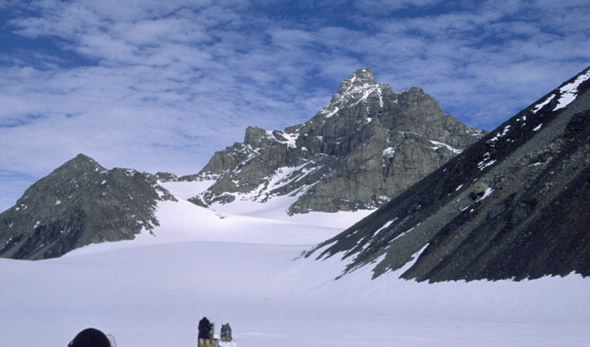Researchers are using cosmic clues in the Antarctic ice sheet to learn more about the variability of our local star, the Sun. These clues involve subtle changes in the concentration of the element, beryllium, produced by cosmic processes in the atmosphere.
 |
Researchers are reading beryllium signals using a 10 million volt particle accelerator and hope to use the results to distinguish historical changes in solar activity and whether they are related to climate variability.
Climate variability is an important topic on the world's political and scientific agendas. Unravelling human-induced climate variability is a challenge researchers are tackling by investigating the Earth's past climate before the influence of humans, and ancient polar ice sheets are playing a key role. Senior researcher and project leader, Dr Andrew Smith explained that the Sun drives the climate of Earth so understanding its past activity is important.
"Earth's climate results from energy the Sun deposits on Earth which is a balance between how brightly the Sun shin
es and how reflective the Earth is albedo," he said.
"During Earth's history both have changed and we are trying to understand how this might be linked to past climate.
"It is widely agreed that solar activity is a minor contributor to the observed warming of the last century," he observed.
"However, over longer periods some researchers argue that variable solar activity may have played a leading role in causing climate variability on Earth."
Andrew explained that an important indicator of solar variability is cosmogenic beryllium, which is produced in the atmosphere by 'galactic cosmic rays'. The amount of beryllium found in ice sheets may be used to reconstruct the Sun's past activity.
"The Earth is constantly bombarded by these energetic protons and neutrons, thought to be formed in distant supernova explosions, far more energetic than our largest particle accelerators can produce," he said.
"On entering the Earth's atmosphere, cosmic rays collide with gas atoms, initiating a cascade of atomic and subatomic particles. These energetic secondary particles continue the process, smashing apart atomic nuclei all the way to the Earth's surface and a few metres below, producing the element beryllium fragments of oxygen and nitrogen nuclei that have been smashed into the smaller beryllium nucleus."
The isotopes of beryllium are useful to scientists. The stable beryllium nucleus contains four protons and five neutrons and has an atomic mass of nine.
Beryllium has two radioisotopes of interest; beryllium-10, with an extra neutron and a half life of 1.5 million years, and beryllium-7, with only three neutrons and a half life of just 53 days.
"It's because both radioisotopes are produced in the same way, yet have such widely different half lives, that they can be used to study the processes that transport them from the stratosphere and troposphere into the polar ice sheets," Andrew explained.
"The very different decay rates serve as a 'clock' for air mass age, which is particularly useful for studying the transport of gasses from mid-latitudes to the poles, and vertical gas exchange within the atmosphere.
"The rate at which cosmic rays arrive at Earth, and so the rate at which cosmogenic beryllium is produced, is dependent upon the strength of the magnetic field in the Sun's heliosphere which permeates our solar system, and the strength of the Earth's magnetic field," said Andrew.
"For example, over the 11-year solar cycle cosmogenic beryllium production in the atmosphere varies by up to 50 per cent due to the Sun's changing magnetic field. After production, this beryllium is transported within air masses in the stratosphere and troposphere before eventually being deposited to the ground.
"Some of this beryllium is deposited to the polar ice caps and archived within the annual snow layers so ice cores and snow pits allow the variations in the concentration of cosmogenic beryllium to be used to reconstruct the history of solar activity beyond current instrument records," he explained.
"Scientists want to know how constant the 11 year solar cycle was before our instrumental records and cosmogenic beryllium in ice sheets allows us to examine this question, but a better understanding of the processes which deliver cosmogenic beryllium to the polar ice caps is needed."
Postgraduate student Joel Pedro from the University of Tasmania is doing just that. He's working with Andrew to investigate beryllium-10 in Arctic and Antarctic ice using the ANTARES Accelerator Mass Spectrometer at ANSTO.
So far, results from detailed snow pit records at Law Dome, East Antarctica have provided new insights into cosmogenic beryllium transport and deposition.
"We found that meteorological effects are influencing the beryllium-10 record in a way that may compromise the standard techniques for reconstructing solar activity," said Joel.
"In addition we have uncovered evidence of a short-lived 'spike' in beryllium-10 production, caused by solar cosmic rays when the Sun burped in January 2005.
"Ice cores and snow pits that can be sampled at approximately monthly resolutions are essential for these studies and adding beryllium-7 measurements gives us extra clues for locating these sorts of events."
This can now be achieved thanks to the commencement of the Australia-Antarctic air link. ANSTO researchers now have faster access to snow core samples than was possible by ship and rapid return of samples to Australia has also allowed measurement of the much shorter-lived beryllium-7 signal.
"Our work so far has been good preparation for an air-supported expedition to Law Dome planned for the summer of 2008," said Andrew.
"This expedition will allow for a detailed comparison of both cosmogenic beryllium radioisotopes along with ongoing studies on ice cores and snow pit samples already collected and in cold storage.
"This work should improve the ability to decipher cosmogenic beryllium records to reveal past changes in solar activity and, in turn, allow a better understanding of the Sun's role in climate variability on Earth," he concluded.
This research is undertaken in ANSTO's Cosmogenic climate archives of the Southern Hemisphere project and is partly supported by AINSE.
Published: 18/06/2008

